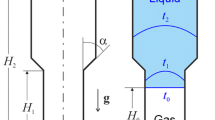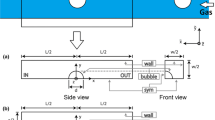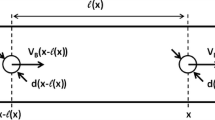Abstract
A configuration like an upside-down bell made of porous material is considered which is initially dry but then subjected to a rising pool of liquid. As liquid touches the rim of the bell, capillary transport is initiated. Starting with a vertical wicking phase, the imbibing liquid will eventually reach the ceiling of the bell and switch over to horizonal wicking. At the end of the horizontal wicking, the cavity inside the porous bell is enclosed by liquid and the gas inside it is captured. We present a model to describe the capillary transport in the bell for both Cartesian and cylindrical geometry. As far as possible, we derive analytical solutions to the normalized differential equations that describe the problem. Beyond analytical solutions, we use Runge–Kutta shooting method to obtain numerical results. We calculate the normalized closure time to capture the gas, the amount of captured gas, and reflect on the pressure development in the gas chamber.













Similar content being viewed by others
Abbreviations
- \(a\) :
-
Wicking constant, relates surface pressure to viscous stress (\(\mathrm {m^2/s}\))
- \(b\) :
-
Wicking constant, relates hydrostatic pressure to viscous stress (\(\mathrm {m^2/s}\))
- \(\mathrm {Bo_\theta }\) :
-
Type of Bond number, relates hydrostatic to surface pressure
- \(\mathrm {Bo_c}\) :
-
Critical Bond number corresponding to \(X_0\)
- \(d\) :
-
Thickness of the porous walls of the cavity (\(\mathrm {m}\))
- \(\mathrm {Fo}\) :
-
Forchheimer number, relates convective to viscous pressure loss
- \(g\) :
-
Earth gravity constant, \(g=9.81~\mathrm {m/s^2}\)
- \(H\) :
-
Height of the porous walls of the cavity (\(\mathrm {m}\))
- \(\Delta h\) :
-
Hydrostatic height between wicking front and liquid reservoir (\(\mathrm {m}\))
- \(K\) :
-
Hydraulic permeability of the porous medium (\(\mathrm {m^2}\))
- \(L\) :
-
Combined vertical and horizontal length (\(\mathrm {m}\))
- \(L_\sigma \) :
-
Capillary length (\(\mathrm {m}\))
- \(\Delta p\) :
-
Pressure difference between front and back side of the cavity ceiling (\(\mathrm {Pa}\))
- \(Q\) :
-
Liquid flow rate (\(\mathrm {m^3/s}\))
- \(r\) :
-
Radial coordinate (\(\mathrm {m}\))
- \(r^*\) :
-
Dimensionless radial position of the wicking front
- \(R\) :
-
Radial position of the wicking front (\(\mathrm {m}\))
- \(R_0\) :
-
Radius of the porous walls of the cavity (\(\mathrm {m}\))
- \(R_s\) :
-
Static radius of the pores (\(\mathrm {m}\))
- \(S\) :
-
Saturation of the pores with liquid, between 0 and 1
- \(t\) :
-
Time (\(\mathrm {s}\))
- \(t^*\) :
-
Dimensionless time
- \(t_d\) :
-
Delay time until liquid contacts the cavity (\(\mathrm {s}\))
- \(u\) :
-
Rising velocity of the liquid (\(\mathrm {m/s}\))
- \(v_\bot \) :
-
Velocity of gas cross flow through the cavity ceiling (\(\mathrm {m/s}\))
- \(\Delta V_\mathrm{{jump}}\) :
-
Volume between outer and inner edge profile at liquid contact (\(\mathrm {m^3}\))
- \(W\) :
-
Width of the porous walls of the cavity (Cartesian) (\(\mathrm {m}\))
- \(x\) :
-
Horizontal coordinate (Cartesian) (\(\mathrm {m}\))
- \(x^*\) :
-
Dimensionless horizontal position of the wicking front
- \(X\) :
-
Horizontal position of the wicking front (\(\mathrm {m}\))
- \(X_0\) :
-
Aspect ratio, wicking height to total wicking length
- \(z\) :
-
Vertical coordinate (\(\mathrm {m}\))
- \(z^*\) :
-
Dimensionless vertical position of the wicking front
- \(Z\) :
-
Vertical position of the wicking front (\(\mathrm {m}\))
- \(\Delta z\) :
-
Height difference due to wall adhesion (\(\mathrm {m}\))
- \(\phi \) :
-
Porosity of the cavity
- \(\Gamma \) :
-
Aspect ratio, radial to total wicking length
- \(\mu \) :
-
Dynamic viscosity of the liquid (\(\mathrm {kg/(m~s)}\))
- \(\theta \) :
-
Contact angle
- \(\rho \) :
-
Liquid density (\(\mathrm {kg/m^3}\))
- \(\sigma \) :
-
Surface tension (\(\mathrm {N/m}\))
- \(\Pi _\mathrm{{u}}\) :
-
Dimensionless parameter, relating wicking time to pool rise time
- \(\Pi _\mathrm{{c}}\) :
-
critical \(\Pi _\mathrm{{u}}\) corresponding to \(X_0\)
References
Aubertin, M., Cifuentes, E., Apithy, S., Bussiere, B., Molson, J., Chapuis, R.: Analyses of water diversion along inclined covers with capillary barrier effects. Can. Geotech. J. 46, 1146–1164 (2009)
Barth, H.: Sustainable and effective irrigation through a new subsoil irrigation system. Agric. Water Manag. 40, 283–290 (1999)
Ben-Gal, A., Lazorovitch, N., Shani, U.: Subsurface drip irrigation in gravel-filled cavities. Vadose Zone J. 3(4), 1407–1413 (2004)
Bennion, D., Bietz, R., Thomas, F., Cimolai, M.: Reductions in the productivity of oil and low permeability gas reservoirs due to aqueous phase trapping. J. Can. Pet. Technol. 33(9), 19–30 (1994)
Bennion, D., Thomas, F., Bietz, R.: Water and hydrocarbon phase trapping in porous media-diagnosis, prevention and treatment. J. Can. Pet. Technol. 35(10), 1–8 (1996)
Blom, C., Voeseneck, L.: Flooding: the survival strategies of plants. Tree 11(7), 290–295 (1996)
Bronstein, I., Semendjajew, K.: Handbook of Mathematics, 3rd edn. Springer, Berlin (1997)
Conrath, M., Dreyer, M.E.: Gas breakthrough at a porous screen. Int. J. Multiph. Flow 42, 29–41 (June 2012)
Conrath, M., Fries, N., Zhang, M., Dreyer, M.E.: Radial capillary transport from an infinite reservoir. Transp. Porous Media 84(1), 109–132 (2010)
Conrath, M., Smiyukha, Y., Fuhrmann, E., Dreyer, M.: Double porous screen element for gas-liquid phase separation. Int. J. Multiph. Flow 50, 1–15 (April 2013)
Danino, D., Marmur, A.: Radial capillary penetration into paper: limited and unlimited liquid reservoirs. J. Colloid Interface Sci. 166(1), 245–250 (1994)
de Gennes, P.: Wetting: statics and dynamics. Rev. Mod. Phys. 57(3), 827–863 (1985)
Dodge, F.: The New Dynamic Behavior of Liquids in Moving Containers. Southwest Research Institute, San Antonio (2000)
Fries, N., Dreyer, M.: An analytic solution of capillary rise restrained by gravity. J. Colloid Interface Sci. 320, 259–263 (2008)
Furlan, P.: Das gelbe Rechenbuch fr Ingenieure, Naturwissenschaftler und Mathematiker: Rechenverfahren der hheren Mathematik in Einzelschritten erklrt, Mit vielen ausfhrlich gerechneten Beispielen. Band 3: Gewhnliche Differentialgleichungen, Funktionentheorie, Integraltransformationen, partielle Differentialgleichungen. Furlan, Dortmund (2004)
Hickman, G.: Adaptiveness of tunnel system features in subterranean mammal burrows. Prog. Clin. Biol. Res. 335, 185–210 (1990)
Jurn, J.M., Kudlac, M.T.: Nasa glenn research center creek road complex—cryogenic testing facilities. Cryogenics 46, 98–104 (2006)
Jurns, J.M., McQuillen, J.B.: Liquid acquisition device testing with sub-cooled liquid oxygen. In: AIAA (Ed.), 44th AIAA/ASME/SAE/ASEE Joint Propulsion Conference and Exhibit. No. AIAA 2008–4943. Hartford, CT July 2008
Justin, S., Armstrong, W.: The anatomical characteristics of root and plant response to soil flooding. New Phytol. 106(3), 465–495 (1987)
Kreyszig, E.: Advanced Engineering Mathematics, 9th edn. Wiley, Hoboken (2006)
Kudlac, M.T., Jurns, J.M.: Screen channel liquid acquisition devices for liquid oxygen. In: 42nd AIAA/ASME/SAE/ASEE Joint Propulsion Conference and Exhibit. No. AIAA 2006–5054. AIAA, pp. 1–9. Sacramento, CA, July 2006
Langbein, D.: Capillary Surfaces: Shape, Stability and Dynamics—in Particular Under Weightlessness. Springer, Heidelberg (2002)
Lazarovitch, N., Simunek, J., Shani, U.: System-dependent boundary condition for water flow from subsurface source. Soil Sci. Soc. Am. J. 69, 46–50 (2005)
Lucas, R.: Ueber das zeitgesetz des kapillaren anstiegs von fluessigkeiten. Kolloid Z. 23, 15–22 (1918)
Lukas, D., Soukupova, V.: Recent studies of fibrous materials wetting dynamics. In: Index 99 Congress, pp. 1–11. Geneva, Switzerland 1999
Maitland, D., Maitland, A.: Significance of burrow-opening diameter as a flood-prevention mechanism for air-filled burrows of small intertidal arthropods. Mar. Biol. 119, 221–225 (1994)
Marmur, A.: The radial capillary. J. Colloid Interface Sci. 124(1), 301–308 (1988)
Suekane, T., Zhou, N., Hosokawa, T., Matsumoto, T.: Direct observation of trapped gas bubbles by capillarity in sandy porous media. Transp. Porous Media 82, 111–122 (2010)
Wang, Z., Feyen, J., van Genuchten, M., Nielsen, D.: Air entrapment effects on infiltration rate and flow instability. Water Resour. Res. 34(2), 213–222 (1998)
Washburn, E.: The dynamics of capillary flow. Phys. Rev. 17(3), 273–283 (1921)
Wildenschild, D., Armstrong, R., Herring, A., Young, I., Carey, J.: Exploring capillary trapping efficiency as a function of interfacial tension, viscosity, and flow rate. Energy Procedia 4, 4945–4952 (2011)
Zhen, Z., Grigg, R.: A criterion for non-darcy flow in porous media. Transp. Porous Med. 65, 57–69 (2006)
Zhou, N., Hosokawa, T., Suekane, T., Wang, Q.: Experimental trapping of capillary trapping on the pore scale of various sandstone cores. Energy Procedia 4, 5017–5023 (2011)
Acknowledgments
The funding of the research project by the German Federal Ministry of Economics and Technology (BMWi) through the German Aerospace Center (DLR) under grant number 50 RL 0921 is gratefully acknowledged.
Author information
Authors and Affiliations
Corresponding author
Electronic supplementary material
Below is the link to the electronic supplementary material.
Rights and permissions
About this article
Cite this article
Conrath, M., Smiyukha, Y. Gas Capture in a Cavity with Porous Walls. Transp Porous Med 103, 131–153 (2014). https://doi.org/10.1007/s11242-014-0292-9
Received:
Accepted:
Published:
Issue Date:
DOI: https://doi.org/10.1007/s11242-014-0292-9




